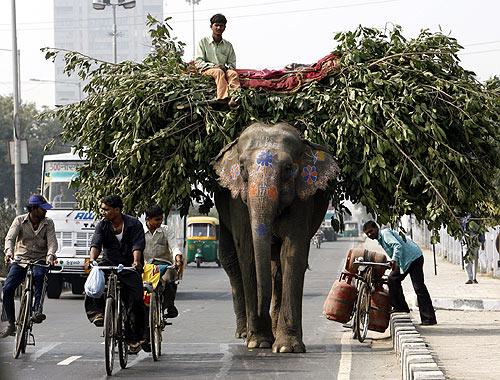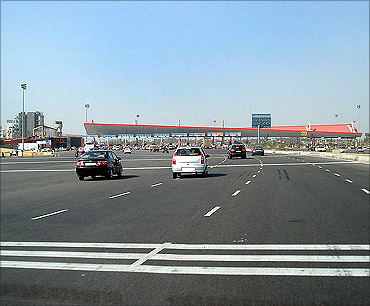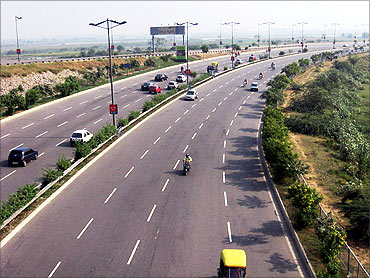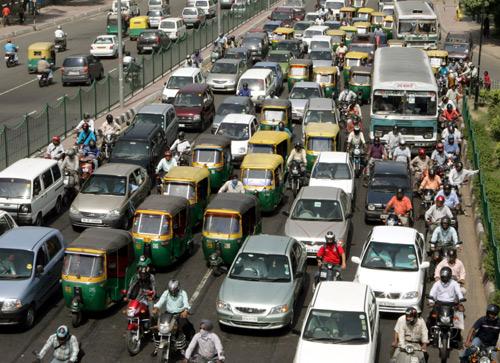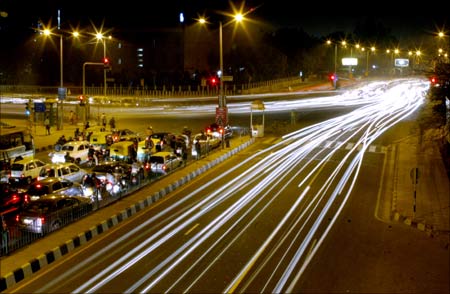 | « Back to article | Print this article |
What is the solution to India's traffic jams?
I write this stuck in traffic. Nothing unusual. But my location makes me realise, once again, how our highway route to progress is going nowhere. The road I am using is newly commissioned and expensive.
It is the 28-km Delhi-Gurgaon Expressway, which was built just a few years ago to take care of the explosion of traffic between the two cities. It is access-controlled, with a 32-lane toll plaza, and was to provide easy access and a fun ride.
The concessionaire – built as it is under the famous public-private partnership model – took all steps to keep it prized for cars. "Slow-moving" traffic like motorcycles, bicycles and even three-wheelers were banned on it.
Click NEXT to read more...
What is the solution to India's traffic jams?
It did not last long. Soon a traffic snarl-up at the toll plaza became an everyday event; commuters decried the daily nightmare and the courts stepped in to fix it.
Recently, the Punjab and Haryana High Court banned the collection of toll charges for 15 days, saying it was not satisfied that all efforts were being made to make travel easier. Cars could now speed past and would not have to wait to pay toll.
But all is not well. Cars speed past the toll and then come to a halt at the next junction - this is where I am stuck on my way back to office from the airport. And then it hits you how this highway is going nowhere. Every time a new expressway or a flyover is built, the point of traffic congestion just shifts; it does not disappear. Roads become a parking lot.
How do we move ahead then? Will more of the same work?
Click NEXT to read more...
What is the solution to India's traffic jams?
In 2008, when the expressway was commissioned, roughly 0.1 million vehicles crossed the toll plaza. In just four years, the number has doubled to 0.2 million vehicles each day. More toll gates are built and more roads and flyovers commissioned. The solution is temporary, but the jams are permanent.
This is the point we miss. In Delhi, an experiment for the future has gone horribly wrong because the city failed to understand its imperative.
The bus rapid transit (BRT) corridor was conceived to provide fast movement to public transport vehicles. The idea was that bus transportation needed reliability, and this needed fast-track corridors to move people, not vehicles.
The plan was to build 14 corridors adding up to some 200 km to make the bus transportation network a real option for commuters.
Click NEXT to read more...
What is the solution to India's traffic jams?
This, combined with the metro train system, would give Delhi a scaled-up alternative for mobility. But from the very start the corridor ran into trouble. Car owners hated it. They said space had been reduced for their travel.
The road space left for buses was envied. Once again, the judiciary came to the defence of the powerful. In this case, the Delhi High Court passed interim orders, destroying the corridor by allowing cars to move into spaces reserved for bicycles and buses.
The report of the Central Road Research Institute (CRRI) – commissioned specially for the court – added to the frenzy against the bus corridor. It also showed the blinkered view of premier road planners.
The institution can see roads, but not people. In the study, CRRI spoke to car owners to establish that speeds were down and concluded that the corridor was not working. It needed to go.
Click NEXT to read more...
What is the solution to India's traffic jams?
But what it glossed over was its own figures that show in peak hours the traffic is not better or worse on the BRT than on the non-BRT road taken as a control in the study.
But what is better in the BRT is that many more people get moved in this road space than in the control road, Aurobindo Marg.
At a crowded junction on the BRT – Chirag Delhi – some 22,000 passengers cross during peak hours. On the control road at the AIIMS crossing, only 11,000 passengers cross during peak hours.
In a 16-hour day, some 200,000 passengers cross this point on the BRT; less than 100,000 cross the crowded junction on the non-BRT road.
Click NEXT to read more...
What is the solution to India's traffic jams?
The key difference is the capacity of the road because of the way people travel. On the BRT, at Chirag Delhi, some 50 per cent of passengers are moved in buses; cars move 26 per cent.
At the AIIMS crossing, cars move 43 per cent of the passengers; buses only 31 per cent. Cars use more space, crowd the road and move far fewer people.
If our educated road planners count people and not vehicles, they will learn what works and what does not.
This is not to say the BRT cannot work better. There is no doubt this corridor, the first of the many that were never built, can be improved.
Click NEXT to read more...
What is the solution to India's traffic jams?
It must provide even better access for pedestrians, spend more on buses and improvise to ease the most congested spots. But the bottom line is this: our cities cannot accommodate present and future car populations.
Doing more of the same is not the way ahead. The only way is to find big ideas for big mobility transition.
The problem is that people do not matter in our cities; cars do. In this situation, BRT becomes the hate symbol while people waste time in traffic jams. This is not the future we seek. I hope.
